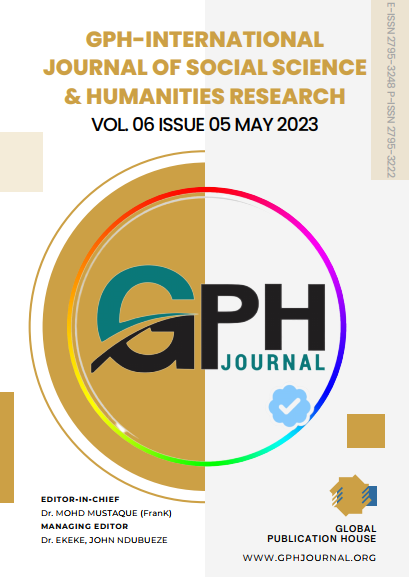COUNSELORS, EDUCATION AND SEXUAL HARASSMENT OF THE GIRL-CHILD IN SECONDARY SCHOOLS: THE NEED FOR REFORMATIVE STRATEGIES
Abstract
Sexual harassment is an organizational issue since it mostly impacts women and has a social and cultural basis for its frequency, expression, and perception. If proper steps are not done to mitigate its effects, it will impede females' academic success. In this context, the study looks at counselors, education, and sexual harassment of girls in secondary schools. It also highlights the necessity for school administrators to use reformative techniques to lessen the impact of sexual harassment of students when it does occur. Secondary data were used in the paper's study. The article made notice of the prevalence of sexual harassment in secondary schools and called for effective ways to lessen its impact on pupils, particularly female ones. The article came to the conclusion that sexual harassment mostly affects young girls, and it recommended that female students act to prevent it by not acting provocatively or seductively, and by avoiding traveling alone whenever possible, especially at night and on lonely paths. In order to prevent sexual harassment in schools, the document recommended that strict measures be put in place. Additionally, the Ministry of Education should hire counselors with proper training and relevant expertise and assign them to secondary schools to propose reformative solutions to current and potential instances.
Downloads
References
Aliu, S. (2001). The Competitive drive, New Technologies and Employment. the human capital. A Paper presented at the Second Tripartite Conference of Manpower Planners: Chelsea Hotel, Abuja.
American Association of University Women (AAUW) (2001). Hostile Hallways, Bullying, Teasing, and sexual Harassment in school, United States. American Association of University Women Educational Foundation
American Association of University Women (AAUW) (2011). Crossing the line, Sexual harassment at school. United States; American Association of University Women
Antwi-Danso, S., & Edet, P.B. (2011) Perceived causes and Effect of School Drop-Out among girls in the Koforidua Municipality, Ghana. The Calabar Counsellor, 5,(5),17-27.
Egbule, E. O. (2013). Counselling for appropriate dressing on campuses of institutions of higher learning in Nigeria. Delta Journal of Guidance and Counselling, 1(1), 77-83
Egbule, J. F. & Egbule, E. O. (2008). Clinical counselling: A psychotherapeutic approach. Real Choice Concept.
Ekong, F. (2006). A gender Appraisal of the Disbursement of bank loans. Ibom Journal of Social Issues, 7(2), 87-101.http://www.iav.nl/epublications/2004/scalingup.pdgKoss,
Maliki, A.E (2011). The effect of teenage pregnancy on adolescents in Amassoma community of southern Ijaw LGA of Bayelsa State. Asian Journal of Social Sciences 1, 62-66.
Obanya, P. (2014) Educationeering: Quality issues in education. Nigeria: HEBN Publishers Plc.
Odoemene, A. (2008).The Nigerian Military and Sexual Violence in ogoni land of niger delta, Nigeria. Paper presented at an International Conference on rape in war time: A history to be written. Institute Historique Allem and, Paris, France.
Omolewa, M. (2003). The roles of faculties of education in African universities. In O.A Bamisaye, I.A Nwazuoke, A. Okediran: Education this millennium innovation in theory and practice. Ibadan: Macmillan Nigeria Publishers Ltd.
Orji, LA. (2011) Importance of girl-child education to nation building. Retrieved from www.phieamaka.blogspot.com March 2nd 2020
Rolfe, S. M. & Schroeder, R. D. (2017). Sticks and Stones may break my bones, but word will never hurt me. Verbal sexual harassment among middle school students. Journal of Interpersonal Violence. www.doi.org/10.1177/0886260517709802
Schultz, T. P. (2012). "Why governments should Invest more to Educate Girls". World Development, 30(2), 207-225
Stop Harassment in Public Schools (SHIPS) (1999). Sexual harassment in school: what students suffer and what schools should do. A guide for student and their parents. Texas; Texas Civil Rights Project
Strauss, S. L. (2012). Sexual Harassment and Bullying. United Kingdom: Rowman and Littlefield Publishers, Inc.
U.S. Department of Education. (2008). Sexual Harassment, It’s not Academic. America; Office for Civil Rights, U.S. Department of Education
UNICEF (2013). International Day of the Girl-Child in South Sudan. In Uterhalter, E., Kioko, E., Pattman, R., Rajagopalan, R., "Scaling girls' education in the commonwealth", London Commonwealth Secretariat, Retrieved from: http/www.i.av.nl
UNICEF, (2004). The state of World's Children. http//www.unicef.org
Vega-Gea E., Ortega-Ruiz, R & Sanchez, V. (2015). Peer sexual harassment in adolescence: Dimensions of the sexual harassment survey in boys and girls. International Journal of Clinical and Health Psychology
Witkowska, E. (2005). Sexual Harassment In Schools: Prevalence, structure and perceptions. Sweden: National Institute for Working Life
Copyright (c) 2023 EGBULE, Elizabeth Osita

This work is licensed under a Creative Commons Attribution-NonCommercial-NoDerivatives 4.0 International License.
The authors and co-authors warrant that the article is their original work, does not infringe any copyright, and has not been published elsewhere. By submitting the article to GPH-International Journal of Social Science and Humanities Research, the authors agree that the journal has the right to retract or remove the article in case of proven ethical misconduct.














 Firozpur Jhirka, Haryana, India
Firozpur Jhirka, Haryana, India

